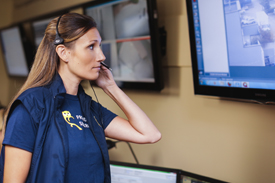
Spending on personal security perk for CEOs is skyrocketing
Companies have been slashing almost every cost imaginable to survive the recession, yet they are spending more than ever to calm CEOs who fear for their personal safety.
Starbucks, which has laid off workers, closed stores and switched from whole to 2% milk to save pennies a gallon, bumped its spending to $511,079 last year on the personal and home security of CEO Howard Schultz. FedEx, which quit matching employee 401(k) contributions, spent $595,875 on the security of CEO Fred Smith. Walt Disney spent $645,368 for CEO Robert Iger; Occidental Petroleum spent $575,407 for Ray Irani; and McKesson spent $401,706 for John Hammergren.
Be it paranoia or prudence, corporate spending on CEO safekeeping is escalating in the face of painful cutbacks, and not by a little. The median spending on personal and home security for CEOs at the 100 largest publicly traded companies was $65,348 in 2008, up 123% from $29,291 in 2007, according to executive compensation research firm Equilar. Ten companies alone spent a total of $4.6 million on CEO security in 2008, 40% more than the 10 biggest spenders of 2007.
Are such fears legitimate – the money wisely spent with every dollar so scrutinized? Companies say yes in their annual proxy filings with the Securities and Exchange Commission, stating that few expenditures are more aligned with the interest of shareholders than safeguarding their corporate leadership. Starbucks says in its proxy that among all perquisites paid to executives, security is “particularly” provided for the company’s benefit.
In times of unpopularity, CEOs can be targets. Last month, the Austrian vacation home of Novartis CEO Daniel Vasella was burned, and police suspect animal-rights extremists. That followed July vandalism when his mother’s urn was stolen from a cemetery, where the grave of his sister, who died at age 19, also was desecrated and someone added crosses with the names of Vasella and his wife.
“Given several notable incidents of violence towards executives, it doesn’t come as a surprise that companies are taking increased measures,” Equilar CEO David Chun says.
The movie industry has largely escaped the recession, and John Marshall, CEO of Commonwealth Studios, says any threat now is probably no worse than before. “Still, when I get in the car I hit the button that locks all the doors, all the little things available to me,” says Marshall, whose home is gated, with an electronic system to warn of intruders. If the alarm sounds, he and his wife have a planned escape route. At work, Marshall contracts for around-the-clock guards and also pays what he describes as “six figures” for a security consultant.
Tough times, tough security
Dell was the security champ among the Fortune 100, spending $1,164,625 protecting CEO Michael Dell in 2008. “The board believes that Mr. Dell’s personal safety and security are of vital importance,” says the company proxy. Dell spokesman Jess Blackburn added that it would be more appropriate to look at salaries, bonuses and other perks, and not focus on security alone.
But CEO security is up like no other perk, and it may be no coincidence that increased spending comes at a time when the image of CEOs is so battered that the public gives them approval ratings worse than members of Congress, according to Rasmussen Reports. CEOs have responded to public outrage by more often paying out of their own pockets for country club memberships and personal use of the corporate jet.
But rarely do they pay for their own home alarm systems or other personal-security measures. Also, dollars reported as a perk in the company proxy are often a fraction of what companies really spend keeping CEOs safe. Large companies such as ExxonMobil have in-house security experts on the payroll. “The company already incurs these costs as a business expense,” the oil company says in its proxy. Even so, ExxonMobil reported $222,985 on the personal security of CEO Rex Tillerson last year, including $57,513 for a trained driver and $122,182 for residential safeguarding.
Companies have long defended the cost of corporate jets because they fold in a layer of security. Security is also the justification for allowing CEOs and their families to make personal trips aboard company aircraft. That is disclosed as a separate perk and not included in the total for security.
Bad economy, good business
Specific CEO security costs that are reported as a perk are escalating, and Chun says that’s due to a perfect storm of layoffs, hostility toward executive pay and outrage over exit packages for CEOs once in charge of companies that had to be bailed out by taxpayers. Rick Wagoner, who resigned as CEO of General Motors in March, received $270,450 in company-paid security in 2008.
“When people become desperate, the threat level is raised,” says Joe Russo, former Secret Service agent in charge of protecting President Clinton and now in charge of executive protection for T&M Protection Resources.
Neither threats to CEOs, nor spending to protect them, is new. Threats often rise in bad economic times or during difficult labor negotiations. In 2001, after wireless equipment maker Ericsson cut 17,000 jobs, CEO Kurt Hellstroem received a mailed death threat along with a bullet cartridge, the Associated Press reported.
Companies were not required to disclose amounts less than $50,000 until 2006, and companies reporting that they paid for the personal and home security of CEOs rose from 23% in 2005 to 54% in 2006, according to Equilar. FedEx has reported that spending on Smith will fall 23% to $461,405 in 2009, but most companies won’t disclose what they are spending on CEO security in 2009 until the spring proxy season of 2010.
Indications are that spending on CEO security has yet to level off. The $10 billion security industry is not immune to recession and expects no growth in 2009, says Mark Visbal, research director for the Security Industry Association. But companies that specialize in protecting the wealthy are having banner years, including 360 Group International. The company’s CEO business is up 50% over the last 12 months, says CEO Bill Kirkpatrick, who figures people get mad and make threats when they lose their jobs and see the CEO “hop a Gulfstream.”
An accurate trend in CEO threats can’t be ascertained because they are rarely disclosed by companies, sometimes not even to police. Tim McKinney, custom home director for industry giant ADT Security Services, which provides electronic security to nearly 5 million commercial, government and residential customers and more than half of the nation’s Fortune 500 companies, says there is chatter in the marketplace about a jump in threats to CEOs, “but we don’t have firm figures to substantiate it.”
CEOs in the USA have rarely been attacked or kidnapped in recent decades as they have been in places such as Colombia. In those higher-risk areas, security is provided for even those who report to the CEO. Coca-Cola has the home of Latin America President Jose Reyes in Mexico City guarded around the clock.
The price we pay for security
Licensed security guards can be had for $20 an hour, and a typical home electronic security system sold by ADT costs $7,000 to $15,000. But McKinney says ADT installed a $300,000 system for the CEO of an unidentified NFL football team a few years ago, and Provident Security of Vancouver, Canada, recently completed two residential camera systems in the $250,000 range, says company President Michael Jagger.
Kirkpatrick says it’s not difficult to envision a $1 million personal-security price tag for a CEO who has a yacht and more than one home that need to be watched around the clock, and who wants a trained bodyguard, known in the industry as a “close protection specialist.” Most CEOs can walk down any street without being recognized, but some like their close protection specialists nearby and obvious, like the ones who guard movie stars.
For about $700,000, ADT says, it will install a perimeter command center inside a custom home. From there it can monitor long-range infrared cameras, fence detectors, motion sensors and provide visitor access. It would also detect fire, carbon monoxide and flood.
“Security is one of those things where you can always spend more,” says Jagger, who says a big-ticket item is the motion camera system that can detect someone lingering outside a fence for more than a few seconds.
That doesn’t mean companies aren’t price sensitive in these tough times, Kirkpatrick says. They demand the best security, but balk at inflated prices and do a lot of comparison shopping.
Many CEOs wind up with the security afforded a king but at a fire sale price, Kirkpatrick says.
Published September 8, 2009 · USA Today · Written by Del Jones
Installation Services
Provident has assembled a first class team of professional alarm technicians who install the latest alarm, CCTV and access control systems.
Read More about how installation works and what we can do for you.

Monitoring & Response Services
The most important reason for installing an alarm system is to generate an immediate response.
Read more on the intrusion detection monitoring services we provide.

Book An Appointment Today
Real security takes more than just an alarm. Our security professionals will show you how to five-minute proof your home or business so that you get the most out of your security investment.
Book Appointment